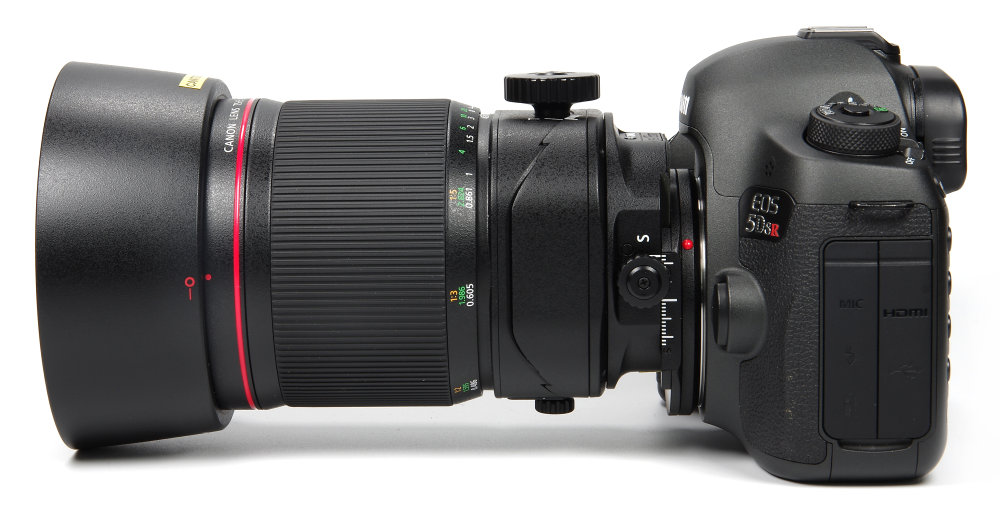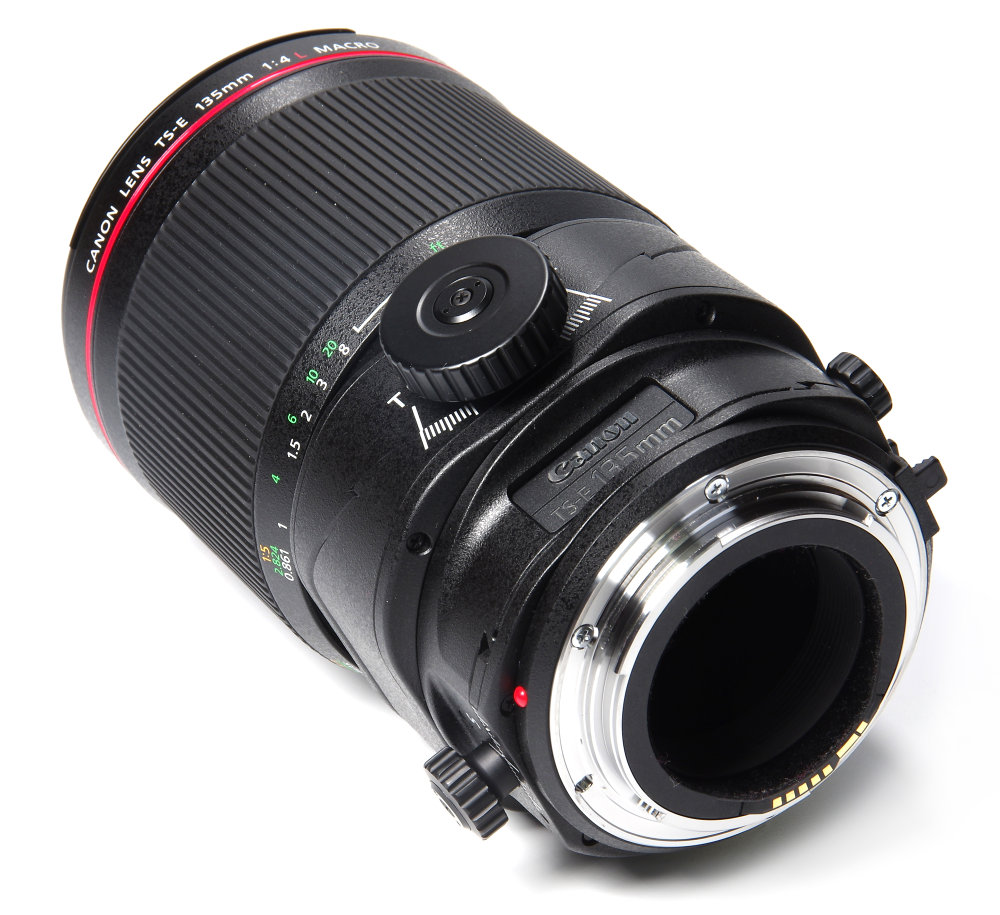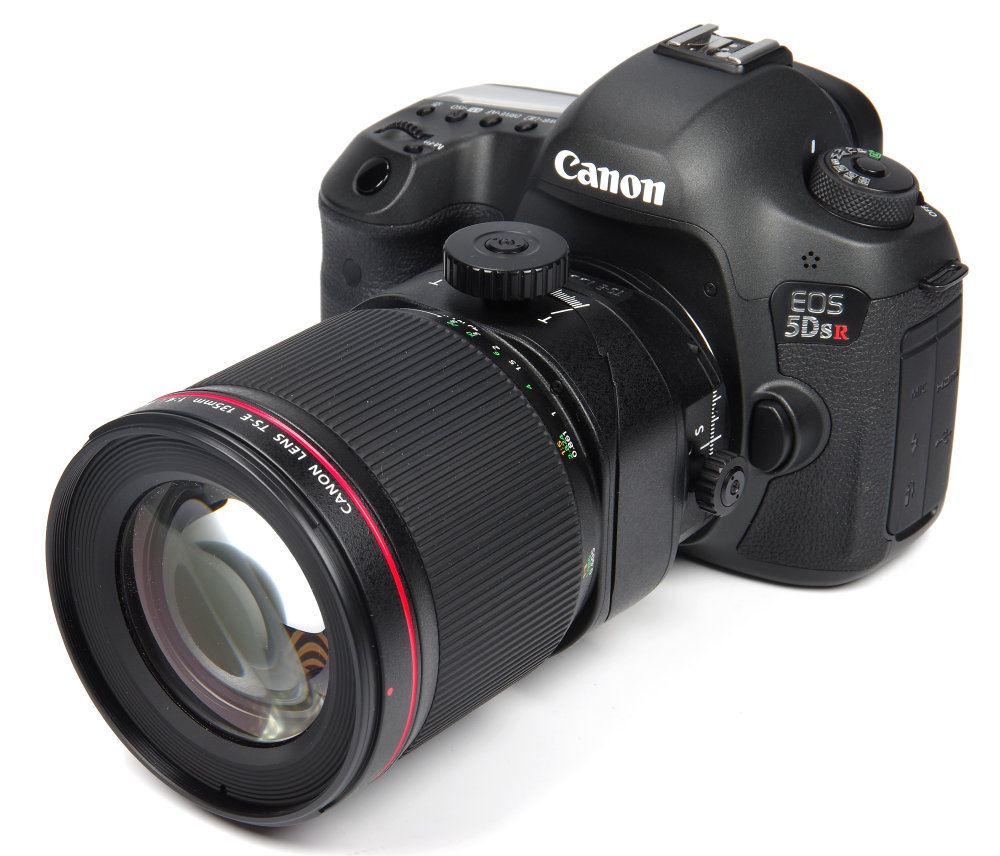Canon TS-E 135mm f/4L Macro Review
Canon TS-E 135mm f/4L Macro Handling and Features
Taking our tour of the lens from the front, a generously sized, round lens hood bayonets precisely into place. There is no chance of this accidentally coming adrift from the lens, thanks to the excellent fit and the provision of a locking catch. There is a standard filter thread taking 82mm filters. The lens does not rotate during focusing, so the use of polarising and graduated filters is made much easier.
Behind this is the wide, ribbed manual focus ring. The lens is manual focus only and adding AF would not really be practical, nor is it particularly missed considering the uses the lens is put to. The action is silky smooth and the image snaps in and out of focus very easily, a benefit of short telephoto lenses in general. The distance scale is marked in feet and metres, although the figures are very small and some may have difficulty deciphering them. The depth of field scale is also very small and really of no benefit whatsoever. There are just markings for f/16 and f/45, but at most distance settings this gives no usable markings to indicate any distance limits.
Magnification ratios are on the distance scale, and these may well be useful information. Focusing is down to 0.486m, or 1.595 feet, representing a maximum magnification of 1:2 or 0.5x. This is also termed half life-size, and is quite an exciting bonus for any 135mm optic and especially so for a tilt and shift lens. It will suit those photographers who prefer longer macro lenses, not quite the iconic 180mm maybe, but nonetheless a long way towards it.
For those who need closer focus, extension tube EF12 II enables a magnification range of 0.62x – 0.09x. Closer still, extension tube EF25 II gives a magnification range of 0.77x – 0.20x. These tubes are of course optional extras. The lens is not compatible with extenders.
Moving closer to the camera body, we find the tilt mechanism. This is controlled by a large knob on the top of the lens, where we also see clear markers indicating the degree of tilt. The underside of the lens has the locking mechanism so that the tilt is not accidentally engaged. Tilt is available over a range of plus or minus 10 degrees.
Next is the shift control, which is also provided with a locking mechanism. The action of both tilt and shift is very smooth, giving a very reassuring feel that exudes a sense of quality and precision. The lens can be shifted plus or minus 12mm.
In addition to this, there are two catches that release the rotation of the tilt and shift positions. These can be adjusted individually so that the direction of tilt or shift can be selected. Endless possibilities exist.

Lens construction is 11 elements in 7 groups, including aspherical and UD (Ultra Low Dispersion) elements. The lens diaphragm comprises 9 blades, although there is no control of the aperture on the lens itself, this being controlled by the camera body. The latest Canon Subwavelength Structure and Air Sphere Coatings are employed.
For a 135mm f/2.8 lens, this all results in a very hefty 1110g package, although it does balance very well with the EOS 5S SR used for this review. For use of the tilt-shift mechanisms, it is quite likely that a tripod will be best, and as the lens has manual focus only that also means that focus can be very accurately set. Despite quite a short throw of the focusing ring, finding a precise point of focus is very easy. It is well worth using live view and the focus aids in the camera as it becomes immediately obvious that the precise point can be pinpointed with a very high degree of accuracy. It is well worth finding this point for optimum results.
Tilt and shift lenses and architecture almost go hand in hand, but with a longer focal length such as this, the perspective we have does not tend to offer the same problems as with a wider lens. We are simply further away and converging verticals are not the same issue. Closer architectural details can benefit, however.
Moving closer and into the macro range different possibilities open up. For example, even with portraiture greater control over the point of focus on the eyes can enable wider apertures to be used at an angle and backgrounds will still fall well out of focus in a way that would not happen when stopped down. Canon offers portraiture as one of the benefits of the lens and it does work out in practice, although for this reviewer a personal preference would be for the shorter 90mm version of the lens.
Close-ups such as product photography also benefit from the control over the plane of focus and this holds true right down to macro distances. The only limitation is our own creativity, although it is likely that more practical considerations will govern making this the lens of choice.
Handling, in general, is excellent. The one proviso is that at some orientations of the tilt and shift mechanisms the locking catches can be very awkward to get to. They cannot be used wearing gloves and even with dexterous fingers can be quite awkward. It is also a very hefty piece of kit and would not be the first choice for a standard 135mm lens, which would be much smaller and lighter. As a TS-E lens, on the other hand, it is quite special.

Add your message
Please login here or if you've not registered, you can register here. Registering is safe, quick and free.
photodo Stats
428 MTF tests
74 in-depth photodo reviews
100+ users join each day
Help the lens community by reviewing or rating a lens today via our lens search
Latest Lens Reviews
- Chinon 28mm f/2.8 Vintage Lens Review
- Canon EF 70-200mm f/4L IS II USM Lens Review
- Samyang AF 85mm f/1.4 EF Review
- Sigma 70mm f/2.8 DG Macro Art Review
- Samyang AF 24mm f/2.8 FE Review
- Meike 50mm f/1.7 Review
- Tamron 70-210mm f/4 Di VC USD Review
- Lensbaby Burnside 35mm f/2.8 Review
- Asahi Super Takumar 50mm f/1.4 Review
- Asahi Super-Multi-Coated Takumar 135mm f/3.5 Review

